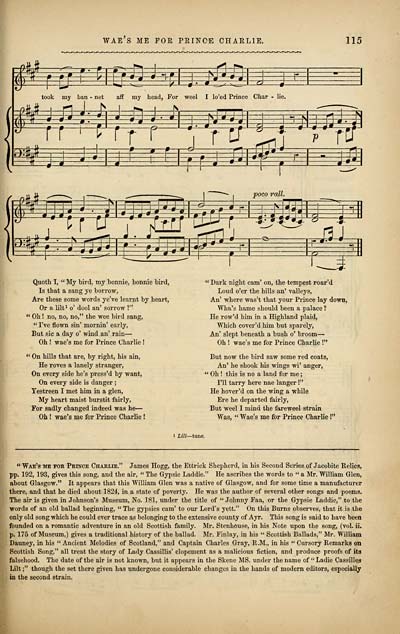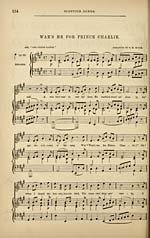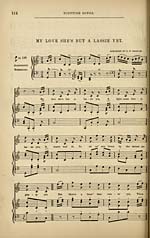Inglis Collection of printed music > Printed music > Songs of Scotland adapted to their appropriate melodies > Volume 1
(131) Page 115
Download files
Complete book:
Individual page:
Thumbnail gallery: Grid view | List view

WAE S ME FOR PRINCE CHARLIE.
115
te^^ p^i
took my ban - net aff my head, For weel I lo'ed Prince Char - lie.
fe^^^ ^fe j^^
333
»
T^-^TT^T
s=^
?
rxr
Btf
M^SeI
J-
aag
^
J.
p r
al
m
poco rail.
Quoth I, " My bird, my bonnie, bonnie bird,
Is that a sang ye borrow,
Are these some words ye've learnt by heart,
Or a lilt 1 o' dool an' sorrow ?"
" Oh ! no, no, no," the wee bird sang,
" I've flown sin' niornin' early,
But sic a day o' wind an' rain —
Oh ! wae's me for Prince Charlie !
" On hills that are, by right, his ain,
He roves a lanely stranger,
On every side he's press'd by want,
On every side is danger ;
Yestreen I met him in a glen,
My heart maist burstit fairly,
For sadly changed indeed was he —
Oh ! wae's me for Prince Charlie !
" Dark night cam' on, the tempest roar'd
Loud o'er the hills an' valleys,
An' where was't that your Prince lay down,
Wha's hame should been a palace ?
He row'd him in a Highland plaid,
Which cover'd him but sparely,
An' slept beneath a bush o' broom —
Oh ! wae's me for Prince Charlie !"
But now the bird saw some red coats,
An' he shook his wings wi' anger,
" Oh ! this is no a land for me ;
I'll tarry here nae langer !"
He hover'd on the wing a while
Ere he departed fairly,
But weel I mind the fareweel strain
Was, " Wae's me for Prince Charlie !"
"Wae's me for Prince Charlie." James Hogg, the Ettrick Shepherd, in his Second Scries of Jacobite Relics,
pp. 192, 193, gives this song, and the air, " The Gypsie Laddie." He ascribes the words to " a Mr. William Glen,
about Glasgow." It appears that this William Glen was a native of Glasgow, and for some time a manufacturer
there, and that he died about 1824, in a state of poverty. He was the author of several other songs and poems.
The air is given in Johnson's Museum, No. 181, under the title of "Johnny Faa, or the Gypsie Laddie," to the
words of an old ballad beginning, " The gypsies cam' to our Lord's yett." On this Burns observes, that it is the
only old song which he could ever trace as belonging to the extensive county of Ayr. This song is said to have been
founded on a romantic adventure in an old Scottish family. Mr. Stenhouse, in his Note upon the song, (vol. ii.
p. 175 of Museum,) gives a traditional history of the ballad. Mr. Finlay, in his " Scottish Ballads," Mr. William
Dauney, in his " Ancient Melodies of Scotland," and Captain Charles Gray, R.M., in his " Cursory Remarks on
Scottish Song," all treat the story of Lady Cassillis' elopement as a malicious fiction, and produce proofs of its
falsehood. The date of the air is not known, but it appears in the Skene MS. under the name of "Ladic Cassilles
Lilt ;" though the set there given has undergone considerable changes in the hands of modern editors, especially
in the second strain.
115
te^^ p^i
took my ban - net aff my head, For weel I lo'ed Prince Char - lie.
fe^^^ ^fe j^^
333
»
T^-^TT^T
s=^
?
rxr
Btf
M^SeI
J-
aag
^
J.
p r
al
m
poco rail.
Quoth I, " My bird, my bonnie, bonnie bird,
Is that a sang ye borrow,
Are these some words ye've learnt by heart,
Or a lilt 1 o' dool an' sorrow ?"
" Oh ! no, no, no," the wee bird sang,
" I've flown sin' niornin' early,
But sic a day o' wind an' rain —
Oh ! wae's me for Prince Charlie !
" On hills that are, by right, his ain,
He roves a lanely stranger,
On every side he's press'd by want,
On every side is danger ;
Yestreen I met him in a glen,
My heart maist burstit fairly,
For sadly changed indeed was he —
Oh ! wae's me for Prince Charlie !
" Dark night cam' on, the tempest roar'd
Loud o'er the hills an' valleys,
An' where was't that your Prince lay down,
Wha's hame should been a palace ?
He row'd him in a Highland plaid,
Which cover'd him but sparely,
An' slept beneath a bush o' broom —
Oh ! wae's me for Prince Charlie !"
But now the bird saw some red coats,
An' he shook his wings wi' anger,
" Oh ! this is no a land for me ;
I'll tarry here nae langer !"
He hover'd on the wing a while
Ere he departed fairly,
But weel I mind the fareweel strain
Was, " Wae's me for Prince Charlie !"
"Wae's me for Prince Charlie." James Hogg, the Ettrick Shepherd, in his Second Scries of Jacobite Relics,
pp. 192, 193, gives this song, and the air, " The Gypsie Laddie." He ascribes the words to " a Mr. William Glen,
about Glasgow." It appears that this William Glen was a native of Glasgow, and for some time a manufacturer
there, and that he died about 1824, in a state of poverty. He was the author of several other songs and poems.
The air is given in Johnson's Museum, No. 181, under the title of "Johnny Faa, or the Gypsie Laddie," to the
words of an old ballad beginning, " The gypsies cam' to our Lord's yett." On this Burns observes, that it is the
only old song which he could ever trace as belonging to the extensive county of Ayr. This song is said to have been
founded on a romantic adventure in an old Scottish family. Mr. Stenhouse, in his Note upon the song, (vol. ii.
p. 175 of Museum,) gives a traditional history of the ballad. Mr. Finlay, in his " Scottish Ballads," Mr. William
Dauney, in his " Ancient Melodies of Scotland," and Captain Charles Gray, R.M., in his " Cursory Remarks on
Scottish Song," all treat the story of Lady Cassillis' elopement as a malicious fiction, and produce proofs of its
falsehood. The date of the air is not known, but it appears in the Skene MS. under the name of "Ladic Cassilles
Lilt ;" though the set there given has undergone considerable changes in the hands of modern editors, especially
in the second strain.
Set display mode to: Large image | Transcription
Images and transcriptions on this page, including medium image downloads, may be used under the Creative Commons Attribution 4.0 International Licence unless otherwise stated. ![]()
| Special collections of printed music > Inglis Collection of printed music > Printed music > Songs of Scotland adapted to their appropriate melodies > Volume 1 > (131) Page 115 |
|---|
| Permanent URL | https://digital.nls.uk/94708544 |
|---|
| Shelfmark | Ing.127 |
|---|---|
| Additional NLS resources: | |
| Attribution and copyright: |
|
| Description | Scottish and English songs, military music and keyboard music of the 18th and 19th centuries. These items are from the collection of Alexander Wood Inglis of Glencorse (1854 to 1929). Also includes a few manuscripts, some treatises and other books on the subject. |
|---|
| Description | The Glen Collection and the Inglis Collection represent mainly 18th and 19th century Scottish music, including Scottish songs. The collections of Berlioz and Verdi collected by bibliographer Cecil Hopkinson contain contemporary and later editions of the works of the two composers Berlioz and Verdi. |
|---|

